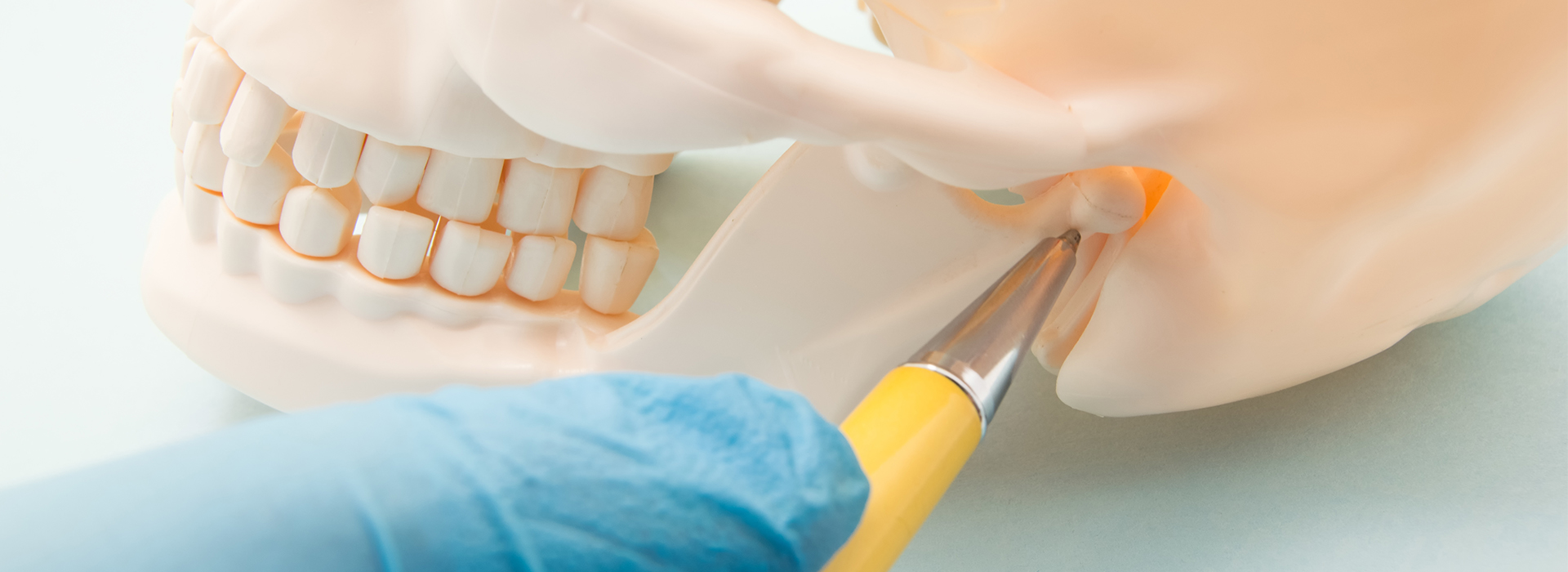New Patients
Existing Patients


Temporomandibular joint (TMJ) disorders can affect the mechanics of the jaw, the comfort of the face, and a person’s daily routine. These conditions range from temporary discomfort to persistent dysfunction, and they are a common reason patients seek dental evaluation for unexplained facial pain or jaw stiffness. At the office of Joanna Tricorache, DDS, we take a careful, conservative approach to diagnosing and managing TMJ concerns so patients can return to normal function with fewer symptoms.
The temporomandibular joint is a paired, complex joint that sits where the lower jaw (mandible) meets the temporal bone of the skull. Each joint contains a soft fibrocartilaginous disc that cushions and coordinates the hinge-and-slide movements required for chewing, speaking, yawning, and other mouth actions. Because the joint combines gliding and rotational movements, small disruptions in any part of the system — bone, disc, muscle, or ligament — can produce noticeable changes in function and comfort.
Muscles and ligaments around the TMJ work in close coordination with dental occlusion (how the teeth come together). This interdependence means that changes in bite, repetitive muscle strain, or localized injury can alter joint loading patterns and trigger symptoms. Understanding the biomechanics helps clinicians identify whether symptoms originate primarily from the joint, the muscles, or a combination of both.
Although the anatomy is robust, the TMJ is vulnerable to a variety of stresses over time. Repetitive behaviors like clenching or grinding and acute events such as a blow to the jaw may cause inflammation, disc displacement, or changes to the joint surfaces. Recognizing the joint’s normal mechanics is the first step toward identifying what has gone wrong and choosing an appropriate plan of care.
TMJ disorders often develop from a mix of factors rather than a single clear cause. Teeth grinding (bruxism) and habitual clenching are frequent contributors because they increase the load on muscles and joint structures, especially at night when awareness is low. Trauma to the jaw, whether from sports injuries, falls, or whiplash, can also introduce structural changes that manifest as pain or dysfunction later on.
Systemic conditions and joint degeneration play a role for some patients. Forms of arthritis, such as osteoarthritis or rheumatoid arthritis, can affect the TMJ and accelerate wear in the joint surfaces or the disc. Hormonal and genetic influences may also make certain individuals more susceptible, and stress or sleep disorders can worsen muscle tension and symptom severity.
Behavioral and lifestyle elements matter too. Repeatedly chewing tough foods, opening the mouth widely for prolonged periods, or poor posture that affects the head and neck can all contribute to ongoing strain. Identifying these triggers is useful because many are modifiable, and addressing them early can prevent symptoms from becoming chronic.
TMJ problems can produce a spectrum of symptoms that vary from person to person. Common complaints include jaw pain or aching around the ear, difficulty opening the mouth fully, and noises such as clicking, popping, or grinding during movement. Some patients report a sensation that the jaw is “locked” or that it moves unevenly when chewing.
Pain is not always limited to the joint. Because the muscles that support the jaw connect to the face, head, and neck, patients often experience related headaches, ear fullness or ringing, and neck stiffness. These referred symptoms can make it challenging to identify the TMJ as the source without a focused evaluation.
Symptoms can come on suddenly after an injury or develop gradually with ongoing strain. For many people, flare-ups are intermittent and respond to rest and home care, but when pain or limitation persists for weeks or months, a clinical assessment is important to prevent long-term changes and to restore comfortable function.
A thoughtful evaluation begins with a detailed history and focused physical exam. Your clinician will ask about the onset and pattern of symptoms, habits like grinding, previous injuries, and any associated headaches or ear symptoms. During the examination, range-of-motion, joint noises, muscle tenderness, and bite relationships are assessed to determine which structures are contributing to the problem.
Imaging is used selectively to clarify joint anatomy when the clinical exam indicates structural concerns. Panoramic or cone-beam radiography can reveal changes in bone, while MRI is the preferred modality for visualizing the position and condition of the joint disc and soft tissues. These tools help distinguish muscle-based pain from internal joint derangement or degenerative change.
Because TMJ disorders often involve both joint and muscle components, a multidisciplinary perspective may be beneficial. Your dentist may collaborate with physical therapists, pain specialists, or medical providers when symptoms are complex. The aim of a thorough evaluation is to identify reversible factors and to build a stepwise treatment plan tailored to the individual.
Most TMJ problems are managed conservatively at first, using strategies that reduce inflammation, decrease muscle tension, and improve joint mechanics. Self-care measures such as eating softer foods temporarily, avoiding wide mouth opening and gum chewing, applying ice or moist heat as recommended, and practicing relaxation techniques can provide meaningful relief. Gentle jaw exercises, when advised by a clinician, help restore mobility and reduce stiffness.
Oral appliances — custom night guards or stabilization splints — are commonly used to protect teeth, reduce nighttime grinding, and redistribute forces on the joint. These devices are non-invasive, reversible, and often effective at reducing muscle overactivity and joint strain. In-office therapies such as targeted injections or short courses of medication may be considered when inflammation or persistent muscle spasm requires additional control.
If conservative care does not resolve symptoms and imaging shows structural problems, more advanced treatments could be explored. These range from minimally invasive joint procedures to, in rare cases, surgical intervention. Decisions about escalation of care are made carefully, weighing potential benefits against risks and focusing on restoring the patient’s comfort and quality of life.
If you are experiencing jaw pain, persistent clicking, difficulty opening your mouth, or other signs that suggest a TMJ problem, an evaluation can clarify the cause and identify practical steps toward relief. Contact our office to learn more about how we assess and manage TMJ disorders and to schedule an appointment for an individualized consultation.

Ready to schedule your next dental appointment or have questions about our services?
Contacting Joanna Tricorache, DDS is easy! Our friendly staff is available to assist you with scheduling appointments, answering inquiries about treatment options, and addressing any concerns you may have. Whether you prefer to give us a call, send us an email, or fill out our convenient online contact form, we're here to help. Don't wait to take the first step towards achieving the smile of your dreams – reach out to us today and discover the difference personalized dental care can make.